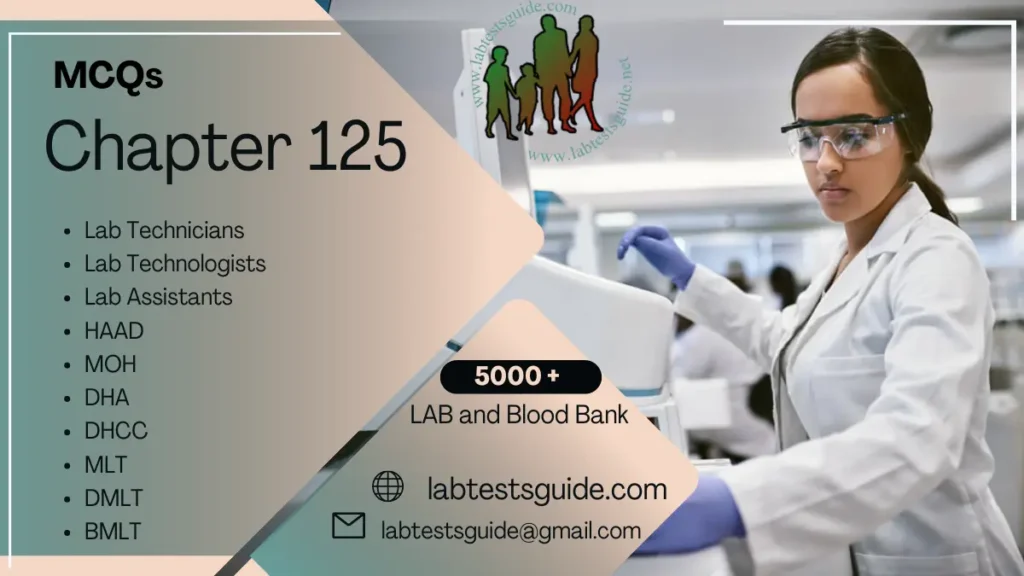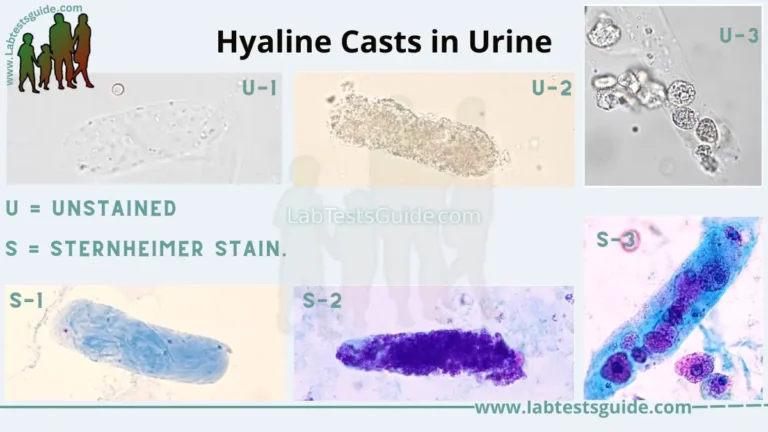6201 to 6250 MCQs for Lab Technician and Technologist Exam Preparation
5000 Plus MCQs for Lab Technician and Technologists are designed to test the knowledge and proficiency of laboratory professionals who work in the field of clinical laboratory science. These questions cover a wide range of topics related to laboratory science, including anatomy, physiology, microbiology, chemistry, and hematology.

If You like then share this to your friends and other social media.
If You have any question and suggestions then please Contact us Here
Questions 6201 to 6250
- Hypervitaminosis K in neonates may cause
- Porphyria
- Jaundice ✔
- Pellagra
- Prolonged bleeding
- Dicoumarol is antagonist to
- Riboflavin
- Retinol
- Menadione ✔
- Tocophero
- In the individuals who are given liberal quantities of vitamin C, the serum ascorbic acid level is
- 1–1.4 µg/100 ml
- 2–4 µg/100 ml
- 1–10 µg/100 ml
- 10–20 µg/100 ml ✔
- The vitamin which would most likely become deficient in an individual who develop a completely carnivorous life style is
- Thiamin
- Niacin
- Vitamin C ✔
- Cobalamin
- In human body highest concentration of ascorbic acid is found in
- Liver
- Adrenal cortex ✔
- Adrenal medulla
- Spleen
- The vitamin required for the formation of hydroxyproline (in collagen) is
- Vitamin C ✔
- Vitamin A
- Vitamin D
- Vitamin E
- Vitamin required in conversion of folic acid to folinic acid is
- Biotin
- Cobalamin
- Ascorbic acid ✔
- Niacin
- Ascorbic acid can reduce
- 2, 6-Dibromobenzene
- 2, 6-Diiodoxypyridine
- 2, 6-Dichlorophenol indophenol ✔
- 2, 4-Dinitrobenzene
- Sterilised milk lacks in
- Vitamin A
- Vitamin D
- Vitamin C ✔
- Thiamin
- Scurvy is caused due to the deficiency of
- Vitamin A
- Vitamin D
- Vitamin K
- Vitamin C ✔
- Both Wernicke’s disease and beriberi can be reversed by administrating
- Retinol
- Thiamin ✔
- Pyridoxine
- Vitamin B12
- The Vitamin B1 deficiency causes
- Ricket
- Nyctalopia
- Beriberi ✔
- Pellagra
- Concentration of pyruvic acid and lactic acid in blood is increased due to deficiency of the vitamin
- Thiamin ✔
- Riboflavin
- Niacin
- Pantothenic acid
- Vitamin B1 coenzyme (TPP) is involved in
- Oxidative decarboxylation ✔
- Hydroxylation
- Transamination
- Carboxylation
- Increased glucose consumption increases the dietary requirement for
- Pyridoxine
- Niacin
- Biotin
- Thiamin ✔
- Thiamin is oxidized to thiochrome in alkaline solution by
- Potassium permanganate
- Potassium ferricyanide ✔
- Potassium chlorate
- Potassium dichromate
- Riboflavin is a coenzyme in the reaction catalysed by the enzyme
- Acyl CoA synthetase
- Acyl CoA dehydrogenase ✔
- β-Hydroxy acyl CoA
- Enoyl CoA dehydrogenase
- The daily requirement of riboflavin for adult in mg is
- 0–1.0
- 1.2–1.7 ✔
- 2.0–3.5
- 4.0–8.0
- In new born infants phototherapy may cause hyperbilirubinemia with deficiency of
- Thiamin
- Riboflavin ✔
- Ascorbic acid
- Pantothenic acid
- Riboflavin deficiency causes
- Cheilosis ✔
- Loss of weight
- Mental deterioration
- Dermatitis
- Magenta tongue is found in the deficiency of the vitamin
- Riboflavin✔
- Thiamin
- Nicotinic acid
- Pyridoxine
- Corneal vascularisation is found in deficiency of the vitamin:
- B1
- B2 ✔
- B3
- B6
- The pellagra preventive factor is
- Riboflavin
- Pantothenic acid
- Niacin ✔
- Pyridoxine
- Pellagra is caused due to the deficiency of
- Ascorbic acid
- Pantothenic acid
- Pyridoxine
- Niacin ✔
- Niacin or nicotinic acid is a monocarboxylic acid derivative of
- Pyridine✔
- Pyrimidine
- Flavin
- Adenine
- The proteins present in maize are deficient in
- Lysine ✔
- Threonine
- Tryptophan
- Tyrosine
- Niacin is present in maize in the form of
- Niatin
- Nicotin
- Niacytin ✔
- Nicyn
- In the body 1 mg of niacin can be produced from
- 60 mg of pyridoxine
- 60 mg of tryptophan ✔
- 30 mg of tryptophan
- 30 mg of pantothenic acid
- The enzymes with which nicotinamide act as coenzyme are
- Dehydrogenases ✔
- Transaminases
- Decarboxylases
- Carboxylases
- Dietary requirement of Vitamin D:
- 400 I.U. ✔
- 1000 I.U.
- 6000 I.U.
- 700 I.U.
- The Vitamin which does not contain a ring in the structure is
- Pantothenic acid ✔
- Vitamin D
- Riboflavin
- Thiamin
- Pantothenic acid is a constituent of the coenzyme involved in
- Decarboxylation
- Dehydrogenation
- Acetylation✔
- Oxidation
- The precursor of CoA is
- Riboflavin
- Pyridoxamine
- Thiamin
- Pantothenate ✔
- ‘Burn ing foot syndrome’ has been ascribed to the deficiency of
- Pantothenic acid ✔
- Thiamin
- Cobalamin
- Pyridoxine
- Pyridoxal phosphate is central to
- Deamination
- Amidation
- Carboxylation
- Transamination ✔
- The vitamin required as coenzyme for the action of transaminases is
- Niacin
- Pantothenic acid
- Pyridoxal phosphate✔
- Riboflavin
- Vitamin B6 deficiency may occur during therapy with
- Isoniazid ✔
- Terramycin
- Sulpha drugs
- Aspirin
- Deficiency of vitamin B6 may occur in
- Obese person
- Thin person
- Alcoholics ✔
- Diabetics
- ‘Xanthurenic acid index’ is a reliable criterion for the deficiency of the vitamin
- Pyridoxal ✔
- Thiamin
- Pantothenic acid
- Cobalamin
- Epileptiform convulsion in human infants have been attributed to the deficiency of the vitamin
- B1
- B2
- B6 ✔
- B12
- Biotin is a coenzyme of the enzyme
- Carboxylase ✔
- Hydroxylase
- Decarboxylase
- Deaminase
- The coenzyme required for conversion of pyruvate to oxaloacetate is
- FAD
- NAD
- TPP
- Biotin ✔
- In biotin-containing enzymes, the biotin is bound to the enzyme by
- An amide linkage to carboxyl group of glutamine
- A covalent bond with CO2
- An amide linkage to an amino group of lysine ✔
- An amide linkage to α-carboxyl group of protein
- A molecule of CO2 is captured by biotin when it acts as coenzyme for carboxylation reaction. The carboxyl group is covalently attached to
- A nitrogen (N1) of the biotin molecule ✔
- Sulphur of thiophene ring
- α-Amino group of lysine
- α-Amino group of protein
- Consumption of raw eggs can cause deficiency of
- Biotin ✔
- Pantothenic acid
- Riboflavin
- Thiamin
- The cofactor or its derivative required for the conversion of acetyl CoA to malonylCoA is
- FAD
- ACP
- NAD+
- Biotin ✔
- A cofactor required in oxidative decarboxylation of pyruvate is
- Lipoate ✔
- Pantothenic acid
- Biotin
- Para aminobenzoic acid
- The central structure of B12 referred to as corrin ring system consists of
- Cobalt ✔
- Manganese
- Magnesium
- Iron
- The central heavy metal cobalt of vitamin B12 is coordinately bound to
- Cyanide group ✔
- Amino group
- Carboxyl group
- Sulphide group
- Vitamin B12 has a complex ring structure (corrin ring) consisting of four
- Purine rings
- Pyrimidine rings
- Pyrrole rings ✔
- Pteridine rings
The questions are typically designed to assess the technical skills and knowledge required for the laboratory profession, including the ability to analyze laboratory test results, perform laboratory procedures, and maintain laboratory equipment.
To prepare for these MCQs, candidates should have a thorough understanding of the key concepts and principles of laboratory science. They should also be familiar with common laboratory equipment and procedures, as well as laboratory safety protocols.
Candidates may also benefit from studying specific laboratory science textbooks or taking online courses that cover the material tested in the MCQs. Additionally, practicing sample MCQs and reviewing the answers can help candidates identify areas where they may need to improve their knowledge or skills.
Overall, the MCQs for lab technologists are designed to be challenging and comprehensive, requiring candidates to demonstrate a high level of proficiency in the field of laboratory science.
Possible References Used





